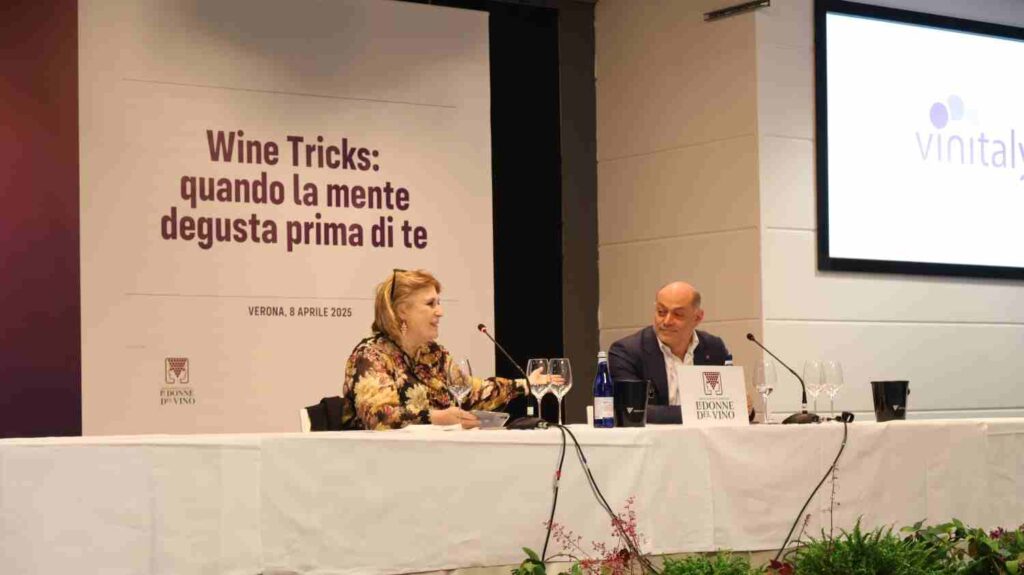Italian young people and wine
Young Italians and wine: they drink it, buy it, and gift it—often without truly knowing it.” This is the picture that emerges from the study “Wine and Young Italians: Habits, Purchases and Perceptions,” presented on Tuesday, April 8 at Vinitaly during the event “Wine Tricks: When the Mind Tastes Before You Do,” promoted by the National Association of Women in Wine and curated by Professor Vincenzo Russo, expert in Consumer Psychology and Neuromarketing at IULM University in Milan.
From Data to Experience: The Wine Tricks Tasting
To bring these statistics to life, the Wine Tricks event took participants on a neuroscientific journey through perception, emotion, and purchasing behavior, offering an immersive experience to reveal how the mind responds to a glass of wine.
From a live eye-tracking experiment—showing a volunteer’s neurological reactions in front of a virtual wine shelf—to the “Super Taster or Low Taster” test for measuring taste sensitivity, and a sensory illusion that sparked reflection on the difference between what we taste and what we perceive—everything helped illustrate how our consumption choices are often driven by unconscious processes.
“Young people aren’t just consumers to be targeted, but individuals to be deeply understood, with their emotions, expectations, and values,” stated Daniela Mastroberardino, President of the National Association of Women in Wine. “Generation Z is curious, sensitive, and far more aware than many assume: they’re not just looking for a good product, but for an experience, a story, a sense of meaning. With Wine Tricks, we wanted to show how much the mind influences our choices, and how understanding how the brain works can help the wine world communicate more empathetically and effectively.”

“Wine is a multisensory and cultural product, but our decisions about it are never purely rational,” explained Professor Vincenzo Russo. “With Wine Tricks, we demonstrated how the mind deeply influences taste perception and purchasing decisions—even before the wine is tasted. Through tools like EEG, eye-tracking, sensory tests, and psychophysiological emotion measurements, we can now better understand how consumers, especially younger ones, experience wine—and how context shapes what we perceive. This is where truly effective communication strategies begin.”
Young Italians and wine: Habits, Purchases and Perceptions
The study conducted by IULM University students highlights that wine consumption among Italian Gen Z (ages 18–25, 188 respondents) is characterized by curiosity but also limited knowledge: on a scale of 1 to 6, self-assessed wine competence averages 2.99.
Most popular wines:
- Red wine remains the most popular (40.8%)
- White wine 38.0%
- Rosé wine 10.6
- Sparkling wines 6.4%
- Dessert wines (3.8%)
- Fortified wines (0.5%).
In terms of where wine is consumed, there’s a clear preference for restaurants (61.1%), followed by at-home consumption (62.0%), bars (20.2%), wine shops (11.7%), events (6.1%), and nightclubs (5.6%).
As for wine purchasing habits:
- the majority are occasional buyers 40.6%
- 26.5% states at they buy wine rarelyth
- Only 5.9% say they purchase it often.
Motivations for buying wine are primarily social:
- Parties 19%
- Gatherings with friends and family 18.2%
- Gifts 15.9%
- Weekends 15.6%
- Personal passion 15.4%
Young people are not inclined to spend much: most fall into the €10–15 (30.5%) and €15–25 (30.2%) price ranges per bottle. Only 12.2% spend more than €25, while 3.3% spend less than €5. The most used purchasing channels are supermarkets (23.2%), followed by restaurants/pizzerias (21.7%), bars (21.2%), and wine shops (19.7%), with online purchases still marginal (14.2%).
Purchase decisions are influenced by:
- Prior consumption experiences 20.2%
- Recommendations from friends and family 19.5%
- Price 19.4%
Factors like labels, packaging, and sustainability matter but play a secondary role. Traditional media (14.5%) and social media (15.2%) have a limited impact. Regarding perception, wine is not strongly associated with social status among young people: statements like “it makes me feel powerful” or “it increases my status” scored between 3.09 and 3.16 on a 1 to 6 scale.

Key facts and features of South African wines you need to know: click here